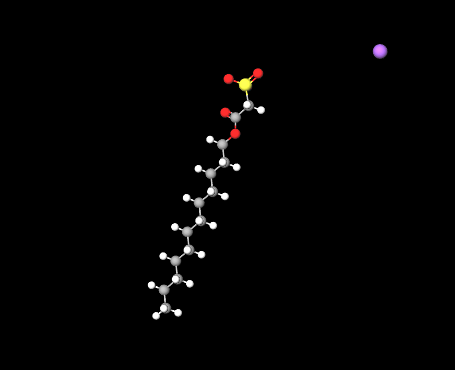| "Descrizione" by Al222 (20718 pt) | 2024-Apr-22 15:47 |
Sodium Lauryl Sulfoacetate (SLSA) is a chemical compound, a surfactant used primarily in personal care products like shampoos, bubble baths, and bath bombs.
The name describes the structure of the molecule:
- Sodium refers to the chemical element sodium. In detergent chemistry, it is often used to form soaps and other surfactant agents.
- Lauryl refers to lauric acid or a 12-carbon chain. It is commonly used in chemical formulas to create substances that help improve foaming and cleansing properties.
- Sulfoacetate is a functional group that contains sulfur and oxygen. It is known for its ability to reduce surface tension between two liquids or between a liquid and a solid, facilitating the removal of dirt and oils.
Chemical Industrial Synthesis Process
- Reagent selection. The production of SLSA begins with the selection of lauric acid and ethyl chloride as the primary raw materials.
- Synthesis. Lauric acid is initially treated with ethyl chloride to form ethyl lauryl chloride, a reactive intermediate.
- Neutralization. Ethyl lauryl chloride is then treated with sodium bisulfate to neutralize it and convert it into sodium lauryl sulfoacetate, which is the SLSA.
- Purification. After synthesis, the product is purified to remove impurities and unreacted by-products, using techniques such as crystallization or filtration.
- Drying. The purified product is then dried to remove residual water and obtain the powdered form of SLSA.
- Quality control. SLSA undergoes quality testing to confirm purity, effectiveness as a surfactant, and to ensure it is free from harmful contaminants.
- Storage. Finally, the powdered SLSA is packaged and stored in conditions that preserve its stability and quality until use.
What it is used for and where
Unlike the more harsh Sodium Lauryl Sulfate (SLS), Sodium Lauryl Sulfoacetate is known for its ability to produce rich foam while being much gentler on the skin and hair. It is particularly valued in products intended for people with sensitive skin as it does not irritate or dry out the skin. This ingredient also contributes to creating a feeling of cleanliness and softness, making products more enjoyable to use.
Cosmetics - INCI Functions
- Cleansing agent. Ingredient that cleanses skin without exploiting the surface-active properties that produce a lowering of the surface tension of the stratum corneum.
- Foaming. Its function is to introduce gas bubbles into the water for a purely aesthetic factor, which does not affect the cleaning process, but only satisfies the commercial aspect of the detergent by helping to spread the detergent. This helps in the commercial success of a cleansing formulation. Since sebum has an inhibiting action on the bubble, more foam is produced in the second shampoo. In practice, it creates many small bubbles of air or other gases within a small volume of liquid, changing the surface tension of the liquid.
- Surfactant - Cleansing agent. Cosmetic products used to cleanse the skin utilise the surface-active action that produces a lowering of the surface tension of the stratum corneum, facilitating the removal of dirt and impurities.
Main uses and benefits of sodium lauryl sulfoacetate.
Detergency. Provides effective cleaning without overly stripping natural oils from the skin, making it suitable for sensitive skin.
Foaming Properties. Produces a rich and luxurious foam, enhancing the user experience in products such as bubble baths, shampoos, and facial cleansers.
Skin Compatibility. It is known for its skin compatibility, reducing the risk of irritations and allergic reactions compared to harsher detergents.
Biodegradability. Due to its plant-based origin, it is readily biodegradable, helping to reduce the environmental impact of cleaning products.
Versatility. It can be used in a wide range of cosmetic products, from skincare to haircare, due to its effectiveness and gentleness.
Solubility. It is soluble in both water and oil, which facilitates the formulation of cosmetic products that require an oil-in-water emulsion.
Safety
Sodium Lauryl Sulfoacetate is generally considered a safe ingredient in cosmetics (1).
 |  |
Molecular Formula C14H27NaO5S
Molecular Weight 330.42 g/mol
CAS 1847-58-1
UNII D0Y70F2B9J
EC Number 217-431-7
DTXSID4027442
Nikkaji J199.662B
Synonyms:
Dodecyl sodium sulfoacetate
Lathanol
Lathanol LAL
Nacconol LAL
References_____________________________________________________________________
(1) Burnett CL, Bergfeld WF, Belsito DV, Cohen DE, Klaassen CD, Liebler DC, Rettie AE, Ross D, Slaga TJ, Snyder PW, Tilton S, Fiume M, Heldreth B. Sodium Lauryl Sulfoacetate. Int J Toxicol. 2023 Dec;42(3_suppl):100S-101S. doi: 10.1177/10915818231204274. Epub 2023 Sep 28. PMID: 37767974.
Abstract. The Expert Panel for Cosmetic Ingredient Safety reviewed updated information that has become available since their original assessment from 1987, along with updated information regarding product types, and frequency and concentrations of use, and reaffirmed their original conclusion that Sodium Lauryl Sulfoacetate is safe as a cosmetic ingredient in the practices of use and concentration as described in this report.
| Evaluate |

